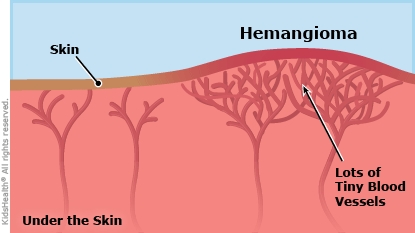Hemangiomas
What Is a Hemangioma?
A hemangioma (hee-man-jee-OH-muh) is a type of birthmark that happens when a tangled group of blood vessels grows in or under the skin.
- A hemangioma that a baby has at birth is called a congenital hemangioma.
- A hemangioma that appears later is called an infantile hemangioma. Infantile hemangiomas are much more common than congenital hemangiomas.
Because hemangiomas grow and change, they're called tumors, but they're not a kind of cancer. A hemangioma will not spread to other places in the body or to other people.

What Are the Signs & Symptoms of a Hemangioma?
Some hemangiomas look like a rubbery red "strawberry" patch of skin, while others may cause a skin bulge that has a blue tint.
Most hemangiomas grow larger during the first year of life. Growth is typically fastest in the first 6 months. They then shrink slowly over the next few years. A hemangioma can cause problems if it affects body functions (such as vision and breathing), bleeds often, or breaks through the skin (called ulcerating).
A baby can have more than one hemangioma.
What Causes Hemangiomas?
Doctors don't know what causes hemangiomas. Sometimes hemangiomas may run in families, but no genetic cause has been found.
Who Gets Hemangiomas?
Hemangiomas are more common in babies who:
- are born early (before their due date)
- are born very small
- are in a multiple birth (twins, triplets, etc.).
Just having a hemangioma doesn't put a baby at increased risk for health problems. But hemangiomas can happen in some syndromes (a syndrome is a combination of signs and symptoms that make up a particular health condition).
How Are Hemangiomas Diagnosed?
Doctors usually can recognize a hemangioma by its appearance. Depending on the hemangioma's type (congenital or infantile) and location, they might do more testing to learn more about the hemangioma.
Rarely, a hemangioma can grow in an organ inside the body, such as the kidneys, lungs, liver, or brain, where it can't be seen.
How Are Hemangiomas Treated?
Often, a hemangioma will shrink (or "involute") without treatment until little or nothing of the blood vessel tangle remains, usually by the time a child is 10 years old. So most hemangiomas are not treated.
Treatment is recommended, though, if a hemangioma:
- blocks vision or eye movements
- reduces air flow through the nose and mouth
- bleeds often or in large amounts
- breaks through the skin covering it
- has enough blood flowing through it to put a strain on the baby's heart
How it's treated depends on the type of hemangioma and other details. Treatment options, which may be used one at a time or in combination, include:
- most commonly, an oral medicine called propranolol or a topical version. Occasionally other medicines are put directly into the hemangioma, given into a vein (with an IV), or taken by mouth (oral).
- surgery to remove the entire hemangioma
- blocking the main blood vessel(s) supplying blood to the hemangioma through embolization, a surgical procedure that involves blocking them from the inside using a long, thin tube (a catheter)
- laser treatments
A hemangioma on a baby's face or head can create a cosmetic (appearance) problem. Doctors understand how much appearance can matter, and will work with parents to decide whether it's better to treat a baby's hemangioma or to let it go away on its own.
What Else Should I Know?
Other kids and adults may be curious about your child's hemangioma. Telling them that hemangiomas are birthmarks that eventually go away will take care of most questions.
After a hemangioma goes away on its own, it may leave behind some stretched skin. Cosmetic (plastic) surgery might be needed to remove the extra skin. Laser treatment can treat skin discoloration.


